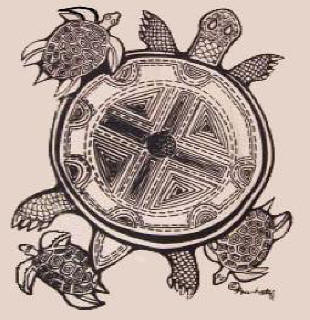|
LITR 4326 Early American Literature Model Assignments |
Final Exam Essays 2016 Sample answers
for
|
 |
Michael Bradshaw
Connection Through Literature
When I first enrolled in early American literature, I was only familiar
with the literature from the dominant culture. I was taught about the founding
fathers in high school, and had read some of the Federalist Papers and the
Constitution. I had only been taught in school that Columbus discovered America.
This class showed me that there are more than just the one America that I had
known, and the importance of teaching them all.
To be
honest, what I had read about before this class was not only a bit boring, but
painfully one-sided. Instead my interest was drawn towards more European
literature, especially folklore and mythology; I blame Tolkien. What I
discovered when reading many of the assignments for this class, especially the
early Native American literature, was that I could identify many common elements
between the texts, and what I had read own my own. In my research posts, I
touched on some of these similarities when I compared the Native American
Trickster Coyote, with his Norse counterpart Loki. However, my fascination with
stories themselves took over, and I spent more time recounting the narratives
when I should have been interspersing commentary throughout in order to more
clearly back up my thesis. Dr. White told me as much in his reply, and I’m
trying to make a conscious effort to focus more on my writing, than that of my
source material. It is something that will help me going forward in my
educational career.
Only
being taught one side of the story before this class, it was interesting, if not
unexpected to see how Native Americans viewed the coming of Columbus. In How
the White Race Came to America… by Handsome Lake,
Hanîsse'ono, “the evil one” is depicted as an invisible man who convinced
Columbus to discover America in order to bring harm to the Native Americans, but
the damage caused was such that Hanîsse'ono lamented his decision. Handsome Lake
created a story in which his people’s version of the devil regrets his actions
because it did so much harm. For a culture to have so much impact on another
that it becomes a tool for “the evil one” in a culture’s folklore is both
fascinating and frightening.
Dr. White did an admirable job attempting to teach both Americas with narratives
from both Native and white perspectives. From reading Handsome Lake, I found
that the white man became a symbol of evil. There is an interesting dichotomy
between Handsome Lake and the captivity narratives. While the Native Americans
believed that the coming of the white man was the worst thing to happen to their
peoples, white people viewed the “savages” as boogeymen who would strike in the
night to slaughter white men, and abduct white women and children.
However, the attitudes of the white man towards the Native Americans seemed to
change during the rise of Romanticism. In 1787, Philip Freneau wrote the poem,
The Indian Burying-Ground, which
paints Native Americans in an almost mystical light. I did a class presentation
on the poem, and in I remarked that Freneau never used the word “savage” in
reference to Native Americans which I believe was a first for the class. Dr.
White postulated that perhaps one of the reasons for the change in attitude was
that the Native Americans were no longer the threat that they once were.
One stanza in particular caught my eye, though I didn’t think to speak on it
until Dr. White brought it up.
“By midnight moons, o’er moistening dews
In habit for the chase arrayed,
The hunter still the deer pursues,
The hunter and the deer- a shade.”
Stanza 9
This brought to my mind images of the Wild Hunt, the spectral hunting party from
European folklore. The Wild Hunt is comprised of either spirits, elves, or other
fairy creatures depending on the region, and roam the skies and forests of
Europe in their endless hunt. Those caught by the Wild Hunt either join or
become quarry. The images of the ghostly hunter brought images to mind of
stories half a world away, which made me recognize that similarities can be
found in unfamiliar places.
The last thing that I expected was to find that my favorite passage of
the semester was actually written by a Founding Father. Given my previous
experiences with their writings, this was the last thing I expected, but the
conviction conveyed by Thomas Paine in his
The Age of Reason, rivalled the most
impassioned evangelist. His proclamation of disbelief in the Christian God, yet
of tolerance for all forms of belief was refreshing to see, and it resonated
with me as I have always had a rocky relationship with organized religion, yet I
can recognize its benefits for many people. To read that a Founding Father had
many of the same beliefs as I do is reassuring and makes the decision for the
separation of church and state in a very Christian country make more sense.
In Early American Literature, I was exposed to literature I never would
have read on my own, and gain a renewed appreciation for literature I had
previously dismissed. I was able to make connections to narratives written
hundreds of years and thousands of miles apart. I was given constructive
criticism for my essays that will help me improve going forward. In a trying
semester, I looked forward to coming to class.
|
|
|
|


